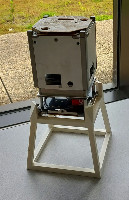| Satellite name | USNA-16 (PSAT3) |
|---|---|
| Type | CubeSat |
| Units or mass | 3U |
| Status | not launched, expected in 2025 |
| Launcher | not launched |
| Organisation | US Naval Academy Satellite Lab |
| Institution | University |
| Entity | Academic / Education |
| Headquarters | US |
| Partners | University of Maryland |
| Oneliner |
Educational amateur radio mission with LoRa digipeater. |
| Description |
USNA-16 will provide UHF LoRa digipeater service to the amateur radio service. Additionally, USNA-16 is a university-student educational amateur radio mission. It will test a modular CubeSat design and integration, as well as the efficacy of student-designed passive magnetic pointing scheme for S-band operation. INCHsat payload will provide UHF service to the amateur radio service. In addition INCHsat payload is a university, student lead, educational amateur radio mission. It will test custom designed and built components. Specifically it will test a custom on-board computer, a custom radio (based off the OpenLST), a custom motherboard, and a custom antenna deployment system. TT&C will occur at UHF (437.235 MHz, will be designated as UHF-TTC in this document) and data downlinks will occur at 2.42GHz, both within the amateur bands and both using the LoRa protocol. This will be the first satellite launched by USNA using LoRa, with a potential future application of APRS over LoRa. USNA-16 will also provide UHF LoRa digipeater service at 437.235 MHz to facilitate communication between amateur operators. INCHSat is a student educational amateur radio mission built by students at the University of Maryland, including the licensee, KC3VBJ. There are no paid employees. The main goal is to enhance the aerospace skills of students in a professional context. The students are learning about satellites and space mission development and space communication by designing, building, and launching a payload onboard a cube satellite. The payload consists of a custom onboard computer, the radio, basic sensors, motherboard, and an antenna deployment system. Communication with the payload will be performed on the 437 MHz band from a ground station that will be constructed on the UMD campus. This payload radio (437MHz) will be designated as UHF-PLD in this document. USNA-16 will have a LoRa digipeater to serve the amateur satellite community. LoRa offers low-power beyond-line-of-sight digital UHF communications to the amateur community. INCHsat payload is for the purpose of the training of UMD students in the construction and development of aerospace components. It also tests the components that we have developed on our own for future missions and research purposes with no commercial benefit. INCHsat payload will have a radio based on the open source OpenLST from Planet Labs to serve the amateur satellite community. INCHsat payload is also a student educational amateur service mission that will be communicating data obtained on amateur frequencies. Pending the mission success the code and schematics of the components used will be published as a cheaper alternative for amateur teams looking to launch a cube satellite. |
| Notes |
General 1U Standard Bus with 2U Payload Module. |
| Sources | [1] [2] [3] [4] |
| Photo sources | [1] [2] [3] |
Last modified: 2024-05-25

